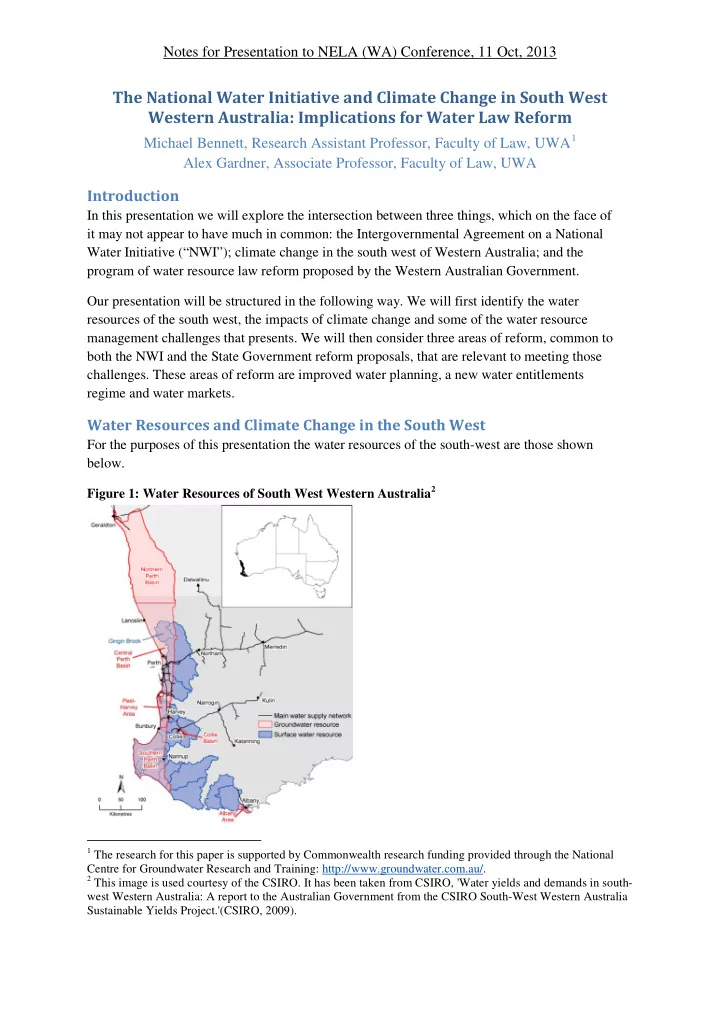

Notes for Presentation to NELA (WA) Conference, 11 Oct, 2013 The National Water Initiative and Climate Change in South West Western Australia: Implications for Water Law Reform Michael Bennett, Research Assistant Professor, Faculty of Law, UWA 1 Alex Gardner, Associate Professor, Faculty of Law, UWA Introduction In this presentation we will explore the intersection between three things, which on the face of it may not appear to have much in common: the Intergovernmental Agreement on a National Water Initiative (“NWI”); climate change in the south west of Western Australia; and the program of water resource law reform proposed by the Western Australian Government. Our presentation will be structured in the following way. We will first identify the water resources of the south west, the impacts of climate change and some of the water resource management challenges that presents. We will then consider three areas of reform, common to both the NWI and the State Government reform proposals, that are relevant to meeting those challenges. These areas of reform are improved water planning, a new water entitlements regime and water markets. Water Resources and Climate Change in the South West For the purposes of this presentation the water resources of the south-west are those shown below. Figure 1: Water Resources of South West Western Australia 2 1 The research for this paper is supported by Commonwealth research funding provided through the National Centre for Groundwater Research and Training: http://www.groundwater.com.au/. 2 This image is used courtesy of the CSIRO. It has been taken from CSIRO, 'Water yields and demands in south- west Western Australia: A report to the Australian Government from the CSIRO South-West Western Australia Sustainable Yields Project.'(CSIRO, 2009).
Bennett and Gardner, The National Water Initiative and Climate Change in SW WA As the CSIRO identified in its 2009 report on water yields and demands in the south west, groundwater and surface water resources provide important economic and social benefits through a variety of consumptive uses. Urban uses, including public water supply, power generation, domestic bores and parks and recreation are largest user of this water, making up 45 per cent of total use. Irrigated agriculture is an important user at 38 per cent, and mining and industry use 7 and 5 per cent respectively. 3 Alongside these consumptive uses, water also sustains natural values in the south west, including four Ramsar wetlands 4 and water- dependent threatened species and ecological communities. 5 In recent decades, reduced rainfall has had a substantial impact on south west water resources. Average rainfall has reduced by 16 per cent since the mid-1970s. 6 This has had a very substantial effect on surface water flows: since the mid-1970s streamflow into the major water supply reservoirs in the south-west have declined by more than 50 per cent. 7 There have also been significant impacts on groundwater, both directly through reduced recharge to aquifers, 8 and indirectly through increased demand for groundwater to substitute for surface water use. 9 Peer-reviewed scientific papers have proposed a number of possible contributions to the reduced rainfall in south west, including land-cover change 10 , multi-decadal variations 11 and 3 Ibid, 129-130. 4 These wetlands are the Forrestdale and Thomsons Lakes; the Peel-Yalgorup System; the Becher Point Wetlands; and the Vasse-Wonnerup System. See Australian Government, Australia’s Ramsar Sites <http://www.environment.gov.au/water/publications/environmental/wetlands/pubs/ramsar.pdf>. 5 P Horwitz et al, 'Hydrological change escalates risk of ecosystem stress in Australia's threatened biodiversity hotspot' (2008) 91 Journal of the Royal Society of Western Australia 7. 6 Indian Ocean Climate Initiative, 'Indian Ocean Climate Initiative Stage 3: Summary for Policymakers' (CSIRO and BoM, 2012); CSIRO, above n 2; R P Silberstein et al, 'Climate change and runoff in south-western Australia' (2012) 475 Journal of Hydrology 441. 7 R P Silberstein et al, above n6. A disproportionately greater reduction in streamflow is to be expected, given that streamflow only occurs once a soil saturation threshold is reached: see Gaia Nugent, Jane Chambers and Peter Speldewinde, Adapting to climate change: a risk assessment and decision making framework for managing groundwater dependent ecosystems with declining water levels. Supporting document 1: Literature review (National Climate Change Adaptation Research Facility, 2013) 10. It also important to appreciate that because catchments have dried so much since the 1970s, the amount of run-off that is generated from a given amount of rainfall has also declined: Don Macfarlane, ‘In south-western Australia, water shortages will worsen’ The Conversation, 20 February 2013 < http://theconversation.com/in-south-western-australia-water-shortages- will-worsen-11947>; Kevin C. Petrone et al, 'Streamflow decline in southwestern Australia, 1950-2008' (2010) 37(11) Geophysical Research Letters 1, p3. 8 For example, it has been estimated that reduced rainfall between 1979 and 2005 was responsible for falls of up to 4 metres in the Gnangara superficial aquifer: Cahit Yesertner, 'Assessment of the declining groundwater levels in the Gnangara Groundwater Mound' (Department of Water, 2008), p v. See also Riasat Ali et al, 'Potential climate change impacts on groundwater resources of south-western Australia' (2012) 475 Journal of Hydrology 456, p459 (Fig 3). 9 Extraction for public water supply from the Gnangara groundwater system expanded substantially to approximately 142GL in 2008, in part due to reduced availability of surface water: E J Roberts James H Skurray, David J Pannell, 'Hydrological challenges to groundwater trading: Lessons from south-west Western Australia' (2012) 412-413 Journal of Hydrology 256, 258. The south west also saw a rapid increase in the number of private bores in response to water use restrictions imposed in the late 1970s:Water and Rivers Commission, Water Facts 12 (August 1998), Department of Water <http://www.water.wa.gov.au/PublicationStore/first/10256.pdf>. 10 A J Pitman et al, ‘The impact of land cover change on the climate of south west Western Australia’ (2004) 109 D18 Journal of Geophysical Research 109. 11 W J Cai, G Shi and Y Li, ‘Multidecadal fluctuations of winter rainfall over southwest Western Australia simulated in the CSIRO Mark 3 coupled model’, (2005) 32(12) Geophysical Research Letters L12701. 2
Recommend
More recommend